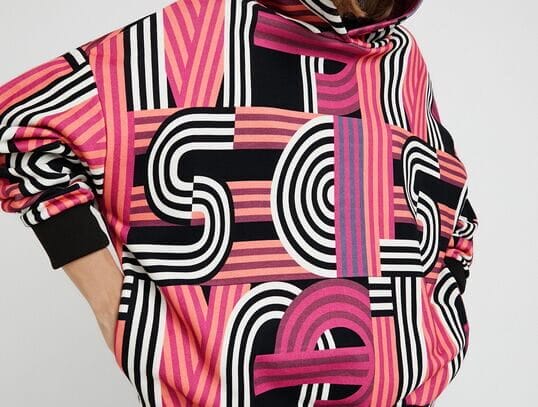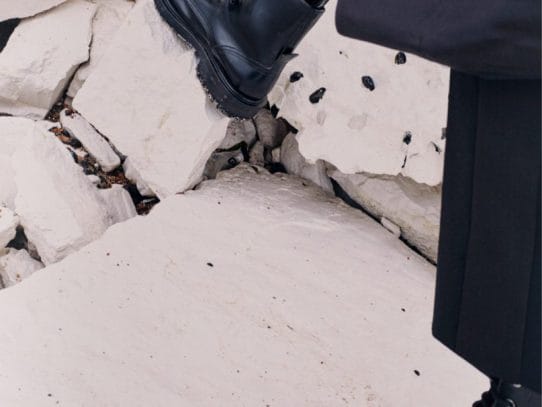Firouz FarmanFarmaian’s Nomads of Persia explores the vibrant legacy of Persian nomadic culture. Presented at Salomon Arts Gallery, this multimedia exhibition blends tradition and innovation through textiles, AI, and soundscapes, creating a transformative experience.
On a chilly December evening, as New York City hummed with holiday cheer, a quiet enchantment unfolded on Leonard Street in Tribeca. Beneath the glow of fairy lights and the faint din of clinking glasses, renowned contemporary artist Firouz FarmanFarmaian opened the doors to his Nomads of Persia exhibition at Salomon Arts Gallery. It was more than just an art opening; it was an immersive celebration of heritage, artistry, and resilience—a perfect antidote to the city’s winter bustle.
Norah Lawlor and the Lawlor Media Group produced an absolutely fabulous event. Their seamless execution and attention to detail made it a standout experience, perfectly complementing the powerful narrative behind Nomads of Persia. From managing press relations to curating an inviting atmosphere, Norah’s expertise ensured the evening was both memorable and meaningful.
The intimate gallery space, tucked within one of Tribeca’s historic buildings, transformed into a multi-sensory portal. Guests—a mix of collectors, art enthusiasts, cultural connoisseurs, and close friends—mingled, their conversations flowing as freely as the wine. The warm lighting and FarmanFarmaian’s intricate works enveloped visitors in a journey that bridged the ancient and the avant-garde, blending Persian tribal traditions with cutting-edge mediums.
As history teaches us, the Iranian Revolution began in 1978 and culminated in 1979, transforming Iran from a monarchy under Shah Mohammad Reza Pahlavi to an Islamic Republic led by Ayatollah Ruhollah Khomeini. Rooted in widespread discontent over political repression, economic disparities, and Western influence, the revolution began with protests in major cities like Tehran and Qom. It drew support from various societal groups, including intellectuals, religious clerics, and the working class. By February 1979, the Shah was overthrown, and Iran was declared an Islamic Republic, significantly altering the country’s governance and cultural landscape by merging religion and state power.
The Qajar Dynasty
The Qajar dynasty ruled Iran from 1789 to 1925, beginning with Agha Mohammad Khan, who established his capital in Tehran. Known for fostering Persian arts, architecture, and culture, the dynasty oversaw a renaissance in visual arts, especially in textiles, miniature painting, and ornate architecture. However, the Qajar era also faced challenges, including territorial losses to Russia and Britain and internal struggles that set the stage for future political upheavals.
A Bloodline of the Qajars
Being a descendant of the Qajar dynasty signifies a direct link to a ruling lineage that shaped Iran’s historical and cultural identity. For artists like Firouz FarmanFarmaian, this heritage imbues their work with a deep connection to Persia’s rich history and traditions, while also confronting the displacement and identity struggles that arise from exile. This perspective allows them to reinterpret and preserve the essence of Persian culture through a modern and innovative lens.
Through my narrative, readers can explore how the Iranian Revolution and the legacy of the Qajar dynasty intertwine with FarmanFarmaian’s artistic expression, creating a vivid tapestry of resilience, history, and cultural evolution.
5 Reasons Why Nomads of Persia Is Unmissable
- The Artist’s Visionary Narrative Born in Tehran and exiled during the Iranian Revolution, FarmanFarmaian’s works are steeped in personal history. A descendant of the Qajar dynasty, he redefines Persian tribal culture through his “post-tribal” lens, weaving exile and identity into a compelling artistic narrative. Each piece—from textiles to AI-powered visuals—tells a story of resilience and cultural preservation.
- A Location That Resonates Salomon Arts Gallery, nestled in the heart of Tribeca, provided the perfect stage for FarmanFarmaian’s finale. The gallery’s blend of industrial charm and artistic pedigree mirrored the exhibition’s juxtaposition of ancient and contemporary. The setting invited guests to pause and reflect, creating an intimate dialogue between the art and its audience.
- Immersive Multi-Format Creations FarmanFarmaian’s ability to harmonize diverse mediums—textile, sound, video, and generative AI—is unparalleled. At the opening, visitors marveled at large-scale works that fused traditional Persian patterns with modern abstractions, while an evocative soundscape provided by his experimental rock band, FORRM, added a hypnotic layer to the experience.
- A Celebration of Connection The evening was not just about art; it was a gathering of kindred spirits. Guests clinked glasses, exchanged ideas, and shared their admiration for the artist’s ability to transcend borders. The air buzzed with conversations about the works’ intricate details, the artist’s story, and the broader cultural implications of his journey.
- A Deeper Purpose At its core, Nomads of Persia is an ode to endangered Persian tribal traditions. FarmanFarmaian’s works act as both a celebration and a call to action, urging audiences to consider the fragility of cultural heritage in an era of displacement. By merging the past with the future, he challenges viewers to rethink identity and belonging in a globalized world.

The Artist and His Journey
Firouz FarmanFarmaian’s journey from Tehran to Paris, and now New York, is woven into every thread of his work. Exiled at a young age, he has spent decades exploring the intersections of memory, history, and modernity. His creations are not merely artworks; they are acts of preservation, rebellion, and reinvention. By collaborating with tribal artisans and incorporating contemporary technologies, FarmanFarmaian crafts pieces that transcend time and geography.
Greta Oriti, Editor of Style Lujo, recently had the opportunity to sit down with contemporary artist Firouz FarmanFarmaian to discuss his latest collection, his innovative use of AI in art, and the profound influence of nomadic cultures on his work. Firouz’s art is a tapestry of tradition and modernity, blending tribal craftsmanship, cutting-edge technology, and spiritual themes. In this engaging conversation, he reflects on his creative process, the cultural narratives behind his pieces, and the significance of connecting to the natural world through art.
Greta Oriti : So, what inspired you to create this collection?
Firouz FarmanFarmaian: Well, I had the honor in 2022 to represent the Republic of Kyrgyzstan, a Central Asian Kyrgyz country, at their pavilion on Venice’s island during the Biennale. I worked with tribal craftswomen from the Tien Shan mountain range to create a textile installation. The project gained recognition, tagged by Art Review as a post-tribal approach. While the response was positive, it raised questions about appropriation—after all, I’m not Kyrgyz. Representing their culture as an outsider inspired me to reflect on my own roots and the tribal cultures in Iran, a country I can no longer visit due to political reasons. This collection, Nomads of Persia, became my answer to those questions and a way to reconnect with tribal traditions through my art.
Greta: Can you speak more about AI? It’s such a big topic right now.
Firouz: Absolutely. As the French poet Arthur Rimbaud said, “You have to be absolutely modern.” For artists today, that means exploring new tools, and AI is one of the most exciting. Artists like Refik Anadol, for example, are pioneering this space with breathtaking digital creations. The process involves creating prompts, training the AI, and essentially collaborating with it to generate digital “hallucinations.” For me, AI is just another medium—a layer I’m exploring to see how it can integrate into my work.
Greta: Are you a fan of AI, or how do you feel about it as a tool?
Firouz: I don’t consider myself a fan of any medium—it’s just a tool. I approach it earnestly to see if it adds value to my art. Like any medium, its worth depends on how effectively it’s used.
Greta: That’s a great perspective. Can you speak more to the textures and designs in your work? How would you describe your art?
Firouz: Tribal, definitely. As I mentioned earlier, my work is rooted in post-tribal concepts, linking contemporary practice to forgotten memories. Whether it’s Native American culture, Persian nomadic traditions, or other indigenous practices, I draw from these to create a dialogue about spirituality and connection to the planet. Nomadic cultures have this innate connection to cosmic forces and nature, which I find deeply inspiring. My goal is to show that you can be modern and still respect ancient spiritual values, like honoring Mother Earth.
Greta: A lot of your work reminds me of graffiti art, especially in its rawness.
Firouz: That’s no coincidence! I’m a child of the ’90s, and graffiti was a big influence. There’s an immediacy in graffiti—you’re often working under pressure, which forces you to get it right the first time. That urgency has carried over into my painting process. Every stroke is intentional, and nothing is done twice.
Greta: Definitely. Can you also speak to your color theory? What influences the colors you use?
Firouz: Color, for me, starts with a manifesto—a clear vision for the project. Much like Yves Saint Laurent or other fashion designers begin a collection with a palette, I choose colors that resonate with the themes of the piece. It’s all about projecting your vision with clarity.
Greta: How do your personal beliefs influence your collections, especially regarding the themes of spirituality and respect for the planet?
Firouz: I wouldn’t call myself an activist—that’s not the role of an artist, in my opinion. Instead, I see myself as a connector. My work isn’t explicitly political, but I do advocate for an “ecology of the soul”—a way of living that respects the planet. This involves drawing inspiration from cultures that already practice this connection, which is something I believe everyone should explore.
Greta: What materials do you use in your art? Are they fair trade or eco-friendly?
Firouz: I consider myself a cross-cultural vessel, and my materials reflect that. From high-quality, hand-loomed textiles to cutting-edge design frames, everything is carefully selected. I strive to incorporate sustainable practices wherever possible, blending traditional craftsmanship with modern innovation.

The Week-Long Journey Through Manhattan
The Salomon Arts Gallery opening marked the grand finale of FarmanFarmaian’s Nomads of Persia tour, which captivated audiences across Manhattan’s most iconic venues. From the experimental rock sounds of FORRM’s GALACTICA at SoHo Playhouse to the ethereal PATH (Into the Vortex) at the Museum of Arts and Design, each event offered a unique lens into the artist’s creative world. The Paintovers exhibition at Lincoln Center’s Furman Gallery—a reimagining of archival materials—was particularly poignant, showcasing the artist’s commitment to merging the old with the new.

A Memorable Night to Close the Year
As the evening in Tribeca drew to a close, guests lingered, reluctant to leave the warm glow of the gallery and the magnetic pull of FarmanFarmaian’s works. On that cold winter night, the hustle and bustle of New York seemed to pause, making way for a deeper, more introspective journey—one that invited everyone to become nomads, if only for an evening.
FarmanFarmaian’s Nomads of Persia will continue to mesmerize at Salomon Arts Gallery through January 14th, 2025. For those who missed the opening, the exhibition promises a transformative experience that will resonate long after the holiday season fades.
Juncture Gallery, founded in 2023 by Camilla and Firouz FarmanFarmaian, is a space dedicated to exploring the profound intersection of art and design. Through their vision, the gallery creates a platform for dynamic, thought-provoking works that challenge and inspire. I’m excited to share that all Nomads of Persia-related pieces, including exclusive units and artworks, are available on Juncture’s Artsy page. Explore the collection here:
Save Article










